|
VicComp INFORMATION CENTER:
For UPDATED Tech Info, please visit
our blog at :
http://viccomputer.blogspot.com
AMD K8 Sockets:
754: The Sempron & Athlon 64
value/budget line, 64-bit memory interface
939: Sempron/Athlon 64
performance line, Athlon 64 X2 and newer Athlon 64 FXs, 128-bit memory
interface
940: Opteron and
old Athlon 64 FX, 128-bit memory interface - Requires registered DDR memory
or ECC
Socket F :
Designed by AMD for its Opteron line of CPUs. The socket has 1207 LGA pins,
and are intended for DDR2 support.
Socket AM2, the 940
pin DDR2-ready officially launched on May 2006, a unified platform for Sempron, Athlon 64, Athlon 64 X2 and Athlon 64 FX.
An old but interesting article about Athlon 64 as it
pertains to silent computing by Bryan Cassell, can be seen
HERE and for printer-friendly version, click
HERE.
AMD K10 Family:
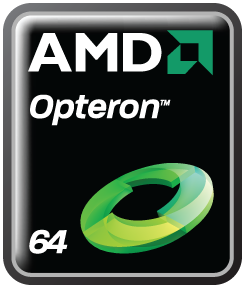  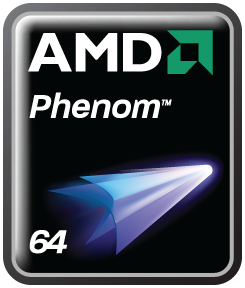
September 10, 2007: Today, AMD officially launched the
first native Quad Core processor with K10 architecture. Codename
Barcelona, it's targeted for Server and called AMD Opteron Quad Core. It
has a new logo and promised to bring improvements such as :
Independent Dynamic Core Technology, AMD CoolCore Technology, Dual Dynamic
Power Management (DDPM), AMD Wide Floating Point Accelerator, AMD Memory
Optimizer Technology, AMD Balanced Smart Cache, and Rapid Virtualization
Indexing.
AMD marked the launch of the Quad-Core AMD Opteron™
processor with celebratory events in venues around the world, including
Bangalore, Barcelona, Beijing, San Francisco, Seoul, Taipei and Tokyo.
AMD, its customers, channel and ecosystem partners came together to
celebrate the unveiling of the world’s first’s native x86 quad-core
microprocessor.
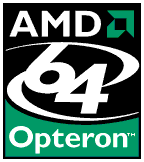    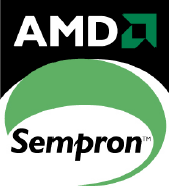
April 22, 2003: the AMD Opteron chip has been officially released. It's
not really a big story for home PC users, because the Opteron is geared to
low-cost 2-way and 4-way business servers. But we do get a peak at how a
1.8GHz Opteron performs in single and dual-CPU systems. The numbers look
quite good for a sub-2GHz chip. This is the first K8 (Hammer) processor with AMD64
architecture.
September 23, 2003: AMD launch the Athlon 64 for Desktop and Notebook,
and also Athlon 64 FX-51 for the enthusiasts.
March 18, 2004: AMD announced its new CPU for
extreme gamers called Athlon 64 FX-53. The architecture of the new processor
is just the same as that of the predecessor, Athlon 64 FX-51. This processor
is designed for Socket 940 mainboards. The only difference from the pervious
processor model is the higher working frequency, which is now 2.4Ghz. [Read
Review
HERE]
July 28, 2004: AMD introduced new budget
processor called SEMPRON. The name is derived from the Latin word, "Semper"
(meaning "always"), and the tech suffix -ron (which apparently means "budget
processor"). Sempron should fall at a lower performance point than
equivalent rated parts from other AMD processor lines. This processor spans
several platforms (Socket A and Socket 754 or even 939
in the future). AnandTech has a review of the Sempron
HERE.
April 03, 2005: AMD starts
shipping its Athlon 64 processors on new E3 core revision also known under
the codename Venice. This core brings into Athlon 64 processors such new
features as SSE3 instructions support, higher core frequency potential via
DSL (Dual Stress Liner) technology which improving the transistors
speed by 24% and manufactured with 90nm SOI production technology.
April 04, 2005:
AMD starts shipping Sempron processors designed for Socket 754 and based
on the new 90nm "E" core stepping (Palermo). And it acquires SSE3
instructions support. The last two letters of the CPU marking, “BO”,
indicate this new core.
COMPUTEX, TAIPEI, TAIWAN -- May 31, 2005
: Completing the world’s only broad dual-core client and server processor
line-up, AMD today announced the immediate availability of the AMD Athlon™
64 X2 dual-core processor. The AMD Athlon 64 X2 dual-core processor is
poised to deliver an experience unmatched in the industry, targeting
prosumer and digital media enthusiasts, as well as those who run many
software applications simultaneously. These new processors, designed for
desktop and desktop-replacement notebooks, shatter the hourglass icon by
delivering performance improvements of up to 80 percent on select digital
media and productivity applications compared to single-core AMD Athlon™ 64
processors. The AMD Athlon 64 X2 dual-core processor will be supported by
leading OEMs including Acer, Alienware, HP and Lenovo, as well as more than
40 leading system-builder partners worldwide.
AMD Athlon 64 X2 4800+ Dual-Core Processor Review @ X-bit labs
AMD Dual Core or Intel Dual Core @ OCWorkBench
June 27, 2005 : AMD is
increasing the speed of their highest performing CPU today. The Athlon 64
FX-57 is a 200MHz bump from the previous FX-55, bringing the clock speed of
the highest performing single core CPU on the market to 2.8GHz. For AMD
Athlon 64 FX-57 Processor Review, click
HERE.
January 09, 2006 : AMD
unveiled its first dual-core processors targeting gamers and performance
enthusiasts. The new chips competes against the recently released Intel
Pentium XE 955 and they both set the bar for the highest-performing
computing platforms. AMD Athlon 64 FX-60 operates at 2.60GHz, contains 2MB
(1MB per core) cache, sports built-in dual-channel PC3200 memory controller
and is drop-in compatible with the 939-pin infrastructure. The part features
x86-64 capability along with essential SSE2 and SSE3 instruction sets,
however, it does not sport virtualization technology, unlike the rival from
Intel, but does support Cool’n’Quiet power-saving feature, somethat the
competitor lacks. “By launching their new dual-core Athlon 64 FX-60
processor, AMD responded worthily to Intel’s Pentium Extreme Edition 955.
There were quite a few cases when the new Intel CPU could probably shaken
AMD’s leadership, however, the just launched AMD Athlon 64 FX-60 doesn’t
leave the competitor even a single chance in almost all of them. Among the
indisputable advantages of the newcomer from AMD targeted for the high-end
pricing segment of the market I should list lower power consumption and heat
dissipation than that of the competitor’s solutions,” said Ilya
Gavrichenkov, an analyst at X-bit labs in his article “AMD
Athlon 64 FX-60 CPU Review”.
May 23, 2006 : We have finally got
a chance to take a real close look at the long-anticipated Socket AM2
platform for AMD processors and the new core revision F (codename
Windsor, Orleans and Manila) for AMD's
processors that have now acquired DDR2-800 SDRAM support. Today we are going
to discuss in great detail the peculiarities and performance of two
newcomers: Athlon 64 FX-62 and Athlon 64 X2 5000+, on
Socket AM2 Platform Review.
December 2006 : AMD 65nm SOI
product unveiled. Brisbane will be AMD’s first 65nm core and is
expected to launch with four parts. The four 65nm Brisbane core based
products include the Athlon 64 X2 5000+, 4800+, 4400+ and 3800+. All four
models will have 2x512KB of L2 cache and a 65W TDP rating. Brisbane will
also have Energy Efficient variants with 35W TDP. Lima is the
codename for single core 65nm and Sparta is the codename for
Semprons.
In the Spirit of Fair and Open Competition, AMD Challenges
Intel to a Duel.... a Dual-Core Duel. Will Intel Accept the Challenge? The
Answer is NO...
Read more here :
http://www.amd.com/duel
6th December 2005 in Singapore - Intel No Show! :
http://www.hardwarezone.com/articles/view.php?cid=1&id=1782
So the hardware community made their own comparisons:
Dual Core Desktop Duel between AMD Athlon 64 X2 vs Intel Pentium D
:
http://reviews.cnet.com/4520-10442_7-6389077-1.html?tag=lnav
Workstation Duel between AMD Opteron vs Intel Xeon :
http://www.xbitlabs.com/articles/cpu/display/opteron-xeon-workstation.html
Advanced Micro Devices, the world’s No.2 maker of
x86 microprocessors, on June 28, 2005 had filed an antitrust lawsuit
against Intel Corp., the world’s largest maker of chips, in U.S. federal
district court for the district of Delaware accusing Intel of unfair
competition. Intel’s illegal and unfair actions include the following:
- Intel has forced major customers into
exclusive or near-exclusive deals;
- Intel has conditioned rebates, allowances and
market development funding on customers’ agreement to severely limit or
forego entirely purchases from AMD;
- Intel has established a system of
discriminatory, retroactive, first-dollar rebates triggered by purchases
at such high levels as to have the practical and intended effect of
denying customers the freedom to purchase any significant volume of
processors from AMD;
- Intel has threatened retaliation against
customers introducing AMD computer platforms, particularly in strategic
market segments;
- Intel has established and enforced quotas
among key retailers effectively requiring them to stock overwhelmingly,
if not exclusively, Intel-powered computers, thereby artificially
limiting consumer choice;
- It has forced PC makers and technology
partners to boycott AMD product launches and promotions;
- Intel has abused its market power by forcing
on the industry technical standards and products which have as their
central purpose the handicapping of AMD in the marketplace.
Read the news
Advanced Micro Devices Sues Intel @ X-Bit Labs
Read An Open Letter
from Hector Ruiz, AMD Chairman, President and Chief Executive Officer
Please read
AMD Full Complaint, so you can get inform how Intel had bullied AMD
for so long.
The U.S. litigation follows a recent ruling from the Fair Trade
Commission of Japan (JFTC) on March 8, which found that Intel abused its
monopoly power to exclude fair and open competition, violating Section 3
of Japan’s Antimonopoly Act. AMD Japan filed two claims on June 30 against
Intel Corp.’s Japanese subsidiary, Intel K.K., in the Tokyo High Court and
the Tokyo District Court for damages arising from violations of Japan’s
Antimonopoly Act. The suit in the Tokyo High Court seeks US$50 million
(approximately 5.5 billion yen) in damages, following on the JFTC’s
findings.
July 12, 2005: The probe against the world’s largest chipmaker Intel Corp. is
continuing to escalate as the European Commission inspectors
raided offices of Intel as well as its partners,
including retailers and computer makers. AMD, Intel’s rival who recently
filed antitrust lawsuit against the company, applauded the move.
“Officials are conducting inspections of several premises of Intel, as
well as the premises of PC manufacturers and retailers in Europe,” said
Jonathan Todd, a representative for the European Commission. The spokesman
did not reveal which of Intel offices as well as which PC manufacturers
and retailers have been visited by investigators. The media notes that the
European Commission launched its first investigation of Intel’s business
practices in late 2000, but had to suspend it due to the lack of evidence
a couple of years later. The inspectors are trying to find out whether
Intel truly offered certain lucrative bargains to those PC makers, who do
not use processors from Intel’s rivals, such as AMD.
Businessweek looks at the European Union setting up to go after Intel
for their controversial businesses practices. Intel has used millions of
dollars in financial incentives to freeze AMD products out of Saturn and
Media Markt stores in Germany. The two retailers, both part of
Dusseldorf-based Metro Group, account for more than one-third of German PC
sales.
July 27, 2007: The European Commission (EC) today
confirmed that it has charged Intel with violating EU competition laws by
abusing its dominant position in the global microprocessor market. The
Commission said in a press briefing today that “in the short, medium and
long-term, we think that the actions of Intel are bad news for competition
and consumers.” The EC specified (http://europa.eu/rapid/pressReleasesAction.do?reference=MEMO/07/314&format=HTML&aged=0&language=EN&guiLanguage=en)
that the charges cover:
- “First, Intel has provided substantial rebates to various Original
Equipment Manufacturers (OEMs) conditional on them obtaining all or the
great majority of their CPU requirements from Intel.
- Secondly, in a number of instances, Intel made payments in order to
induce an OEM to either delay or cancel the launch of a product line
incorporating an AMD-based CPU.
- Thirdly, in the context of bids against AMD-based products for
strategic customers in the server segment of the market, Intel has
offered CPUs on average below cost.”
 |
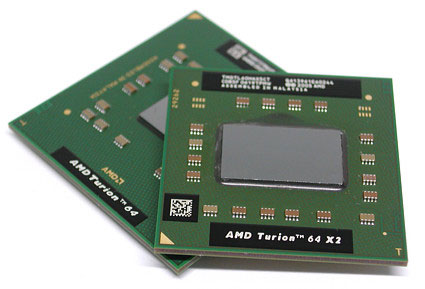 |
| March 10,
2005: AMD is referring to their Turion 64 as a “Mobile
Technology” and not just a microprocessor platform. Turion 64 doesn’t
rely on AMD-supplied chips to receive the branding. AMD will provide the
Turion 64 processors, but chipsets can be provided by a number of
vendors as can the LAN and wireless controllers. AMD is far less
restricting on the components that make up Turion 64 enabled notebooks,
which means that they will inevitably be cheaper than Centrino
platforms. The Turion 64 processor
is basically a 90nm mobile Athlon 64, so all of the architectural
features of the Athlon 64 make their way to the Turion 64. One advantage
that the Turion 64 has is that with an on-die memory controller, AMD can
potentially offer lower memory controller power consumption than Intel.
The Turion 64 is based on the latest
revision E4 of the K8 core, meaning that it supports SSE3 instructions
as well as lower power states. The Turion 64 line also supports AMD’s
PowerNow technology (known as Cool’N’Quiet on the desktop), which allows
for clock speed (and voltage) modulation between 1.0GHz and the
processor’s maximum frequency based on load.
The Turion 64 will be available in both 1MB
L2 and 512KB L2 cache models, but both models will only support a 64-bit
(single channel) DDR400 memory controller. The first Turion 64s will be
available in speeds ranging from 1.6GHz up to 2.0GHz.
With the Turion 64 AMD is introducing a new
model numbering system to help differentiate various Turion CPUs from
one another (and to separate the Turion 64 line from the Athlon 64
line). May 17, 2006:
AMD announced its first 64 bit dual-core laptop processors: the Turion
64 X2 series. Thanks to its two processor cores, these CPUs are capable
of concurrently running several applications. This means that they
substantially reduce input delays when the user switches tasks, and
enable the development of much more powerful laptops. Even better, power
consumption is apparently not much higher than that of its predecessor,
the Turion 64. Unlike its competitor, AMD's Turion 64 X2 mobile platform
is open: the chipset and WLAN components are not made exclusively by
AMD, but come from renowned manufacturers like ATI, nVidia, Airgo,
Atheros and Broadcom. ATI offers two chipset variants for Turion 64 X2
laptop processors: the Radeon Xpress 1100 and 1150. nVidia's portfolio
features a combination of nForce Go 430 MCP and GeForce Go 6150 IGP for
these CPUs. Both chipsets have integrated graphics cores. |
 
During
October 2001, AMD introduced new AMD Athlon XP processor based on 0.18micron
Palomino core. The new Athlon XP used Model Rating.
On June 2002, after a long time, AMD released the Athlon XP based on
0.13micron Thoroughbred core for desktop. Still with 133/266 bus and 256K L2
Cache, the new T-Bred don't have any major architectural changes compared to
the Palomino. After that, AXP 2600+ using improved T-Bred B core surprised
us with its ability to overclock.
On February 10, 2003, AMD launched the Athlon XP 3000+ with Barton core.
With 333MHz FSB and 512KB L2 Cache, Barton is the last core of the Athlon XP
family.
On August 13, 2003, A new update to 400MHz FSB with Athlon XP 3200+ Barton for Socket A processor.
(Posted October 10, 2001, Updated August 13, 2003)
|